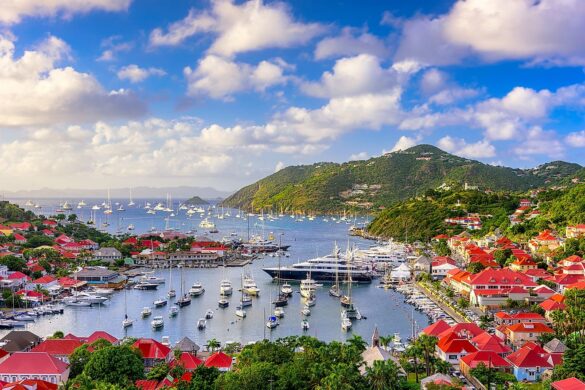The Caribbean region, often perceived as a paradise of azure waters and idyllic beaches, encompasses a tapestry of cultures, histories, and breathtaking landscapes. But what lies beneath the surface? Is it merely a tropical escape, or does it embody a profound narrative shaped by the interplay of geography, culture, and spirituality? As we delve into the essence of the Caribbean, let us explore its countries, unique cultures, and geographical wonders, viewing them through the lens of the Christian faith.
Geographically, the Caribbean is an archipelago situated to the southeast of North America, north of South America, and east of Central America. This vibrant region is composed of over 7,000 islands, islets, reefs, and cays, each possessing its own distinctive identity. The principal islands include Cuba, Jamaica, Hispaniola (which comprises Haiti and the Dominican Republic), and Puerto Rico, among others. Yet, the diversity does not stop with geography; it extends to the richness of the cultures that inhabit these lively lands.
At the heart of the Caribbean experience is a confluence of cultures, a veritable mosaic formed by indigenous peoples, European colonizers, African slaves, and, more recently, East Indian and Chinese immigrants. The legacy of colonization is evident; it has left an indelible mark on the architecture, language, and societal structures within each country. Would you consider how the colonial past has shaped not only the present but also the spiritual fabric of these nations? Many Caribbean nations are predominantly Christian, with Roman Catholicism and Protestantism having significant followings. This alignment with Christianity provides a lens through which many of the region’s inhabitants interpret their history and cultural practices.
In Jamaica, for example, the vibrant Rastafarian movement, which draws heavily on Christian theology, expresses a unique interpretation of faith and identity. It champions peace, love, and resistance against oppression, often drawing from biblical narratives. The significance of faith is also vividly reflected in the annual celebration of Carnival, where participants don fantastical costumes and engage in spirited dances, merging joy with spiritual homage. In contrast, the Dominican Republic exhibits a blend of Catholic rituals and African traditions, as seen in the deeply ingrained celebration of the fiesta, which often incorporates music, dance, and prayer in a way that reflects both reverence and exuberance.
Across the Caribbean, festivals play a crucial role in expressing cultural identity and strengthening community ties. Whether it is the vibrant Junkanoo festival in the Bahamas, characterized by spirited parades and rhythmic drumming, or Trinidad’s Carnival, which features elaborate floats and costumed revelers, these celebrations often invoke spiritual themes. Participants frequently invoke divine blessings through prayer and song, forming a bridge between the sacred and the secular.
From a geographical standpoint, the Caribbean boasts an array of ecosystems, including mangroves, coral reefs, and tropical forests, which are crucial not only to local biodiversity but also to the livelihoods of its inhabitants. The natural beauty of the region can elicit reflections on the divine creation articulated in the Book of Genesis. The intricate balance of nature serves as a testament to the Creator’s artistry. Nevertheless, this is not without its challenges; climate change poses a significant threat to this paradise, leading to increased hurricane intensity and rising sea levels. Herein lies a theological challenge: how does one reconcile the beauty of creation with the realities of environmental degradation and natural disasters? This juxtaposition calls for a deeper inquiry into stewardship, responsibility, and the call to care for God’s creation.
Furthermore, the Caribbean’s varying landscapes—from the volcanic mountains of St. Lucia to the idyllic beaches of Barbados—serve not only as picturesque backdrops but also as reflections of diverse economic realities. While tourism flourishes in many regions, often providing vital income, the reliance on this sector brings forth ethical considerations. How does the local community preserve its identity and culture amidst the overwhelming influence of global tourism? This is a delicate dance between economic necessity and cultural integrity.
In addition to environmental and economic challenges, social issues persist throughout the Caribbean region. Poverty, crime, and political instability remain substantial hurdles. The Christian faith often acts as a beacon of hope amid these difficulties. Churches are frequently at the forefront of community service and support, embodying the call to minister to the most vulnerable. This role highlights an essential element of the Christian doctrine: love for one’s neighbor transcends boundaries and speaks to a collective responsibility to uplift one another.
As we engage with Caribbean culture through prayer, travel, and study, it becomes imperative to do so with awareness and sensitivity. Each country is filled with stories—some hopeful, others tragic—each reflecting the nuanced history and resilience of its people. In recognizing these narratives, one is compelled to ask what role faith might play in fostering unity and healing within communities that have endured centuries of strife.
In conclusion, the Caribbean region represents more than just a picturesque getaway; it is a profound expression of faith, culture, and environmental stewardship. It invites both contemplation and action. As we reflect on the interplay of geography and culture through Christ’s teachings, the challenge lies in how we, as witnesses to this diverse tapestry, choose to respond. Will we embrace our role as stewards, advocates, and allies in the ongoing journey toward community flourishing and spiritual restoration? The answer may shape not only our understanding of the Caribbean but also our collective purpose in the world.



